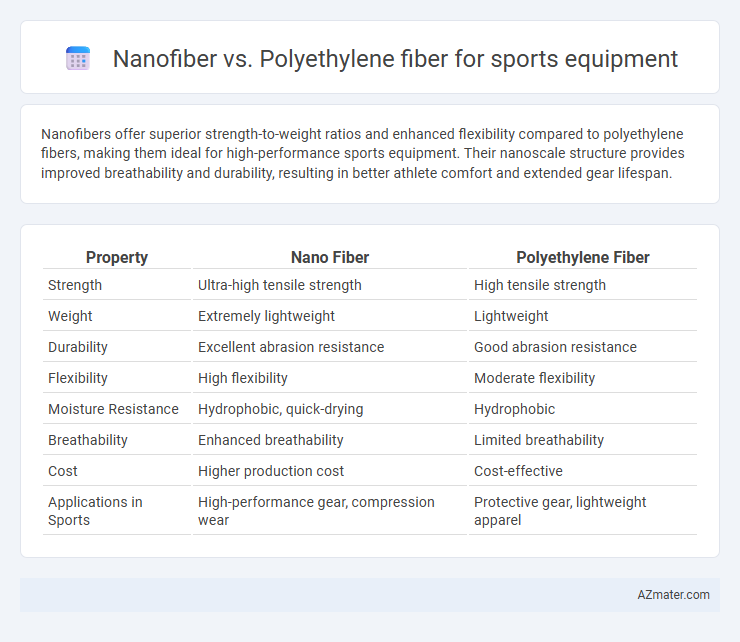Nanofibers offer superior strength-to-weight ratios and enhanced flexibility compared to polyethylene fibers, making them ideal for high-performance sports equipment. Their nanoscale structure provides improved breathability and durability, resulting in better athlete comfort and extended gear lifespan.
Table of Comparison
| Property | Nano Fiber | Polyethylene Fiber |
|---|---|---|
| Strength | Ultra-high tensile strength | High tensile strength |
| Weight | Extremely lightweight | Lightweight |
| Durability | Excellent abrasion resistance | Good abrasion resistance |
| Flexibility | High flexibility | Moderate flexibility |
| Moisture Resistance | Hydrophobic, quick-drying | Hydrophobic |
| Breathability | Enhanced breathability | Limited breathability |
| Cost | Higher production cost | Cost-effective |
| Applications in Sports | High-performance gear, compression wear | Protective gear, lightweight apparel |
Introduction to Sports Equipment Fibers
Nano fibers offer superior strength-to-weight ratios and enhanced flexibility compared to traditional polyethylene fibers, making them ideal for high-performance sports equipment. Polyethylene fibers are valued for their durability, impact resistance, and cost-effectiveness, often used in protective gear and apparel. Advances in nano fiber technology improve moisture management and breathability, providing athletes with enhanced comfort and performance during intense activities.
What Are Nano Fibers?
Nano fibers are ultra-fine fibers with diameters typically under 100 nanometers, offering exceptional strength, flexibility, and lightweight properties that enhance sports equipment performance. Compared to conventional polyethylene fibers, nano fibers provide superior surface area and mechanical properties, improving durability, breathability, and protection in gear such as helmets, gloves, and performance wear. Their nanoscale structure allows for advanced material engineering, increasing energy absorption and resistance to abrasion in high-impact sports applications.
Understanding Polyethylene Fibers
Polyethylene fibers, particularly ultra-high-molecular-weight polyethylene (UHMWPE), are widely used in sports equipment due to their exceptional strength-to-weight ratio, high tensile strength, and impact resistance. These fibers offer superior durability and flexibility compared to traditional materials, making them ideal for items such as protective gear, ropes, and high-performance apparel. Nano fibers, while offering unique advantages in surface area and filtration, generally lack the mechanical robustness and load-bearing capacity inherent to polyethylene fibers in demanding sports applications.
Key Properties Comparison: Nano vs Polyethylene
Nano fibers exhibit superior tensile strength and elasticity compared to polyethylene fibers, enhancing durability and flexibility in sports equipment. Polyethylene fibers provide excellent impact resistance and lightweight properties, ideal for high-performance gear requiring shock absorption. Nano fibers offer enhanced moisture-wicking and breathability, improving comfort during intense physical activity.
Strength and Durability Analysis
Nano fiber materials exhibit superior tensile strength and enhanced durability compared to traditional polyethylene fibers, making them ideal for high-performance sports equipment. The nanofiber's fine structure provides exceptional resistance to wear, abrasion, and impact, extending the lifespan of products such as protective gear and high-stress sports apparel. Polyethylene fibers offer good strength-to-weight ratios but generally lack the advanced mechanical properties and longevity found in nanofiber-enhanced composites.
Flexibility and Comfort in Sports Applications
Nanofibers offer superior flexibility and enhanced comfort in sports equipment due to their ultra-fine diameter and high surface area, allowing for better breathability and lightweight properties compared to polyethylene fibers. Polyethylene fibers, while strong and durable, tend to be stiffer and less breathable, which can reduce comfort during intense physical activities. The advanced flexibility of nanofibers supports improved athletic performance by conforming closely to body movements and reducing skin irritation.
Weight and Performance Impacts
Nano fiber materials offer significantly lower weight compared to traditional polyethylene fibers, enhancing agility and speed in sports equipment applications. The superior tensile strength and flexibility of nano fibers contribute to improved performance by providing better shock absorption and durability during intense activities. Polyethylene fibers, while lightweight, often lack the advanced mechanical properties of nano fibers, resulting in comparatively less efficient energy transfer and protection.
Resistance to Environmental Factors
Nanofiber materials exhibit superior resistance to environmental factors such as UV radiation, moisture, and temperature fluctuations compared to polyethylene fibers, enhancing durability in sports equipment exposed to harsh conditions. Polyethylene fibers, while lightweight and strong, tend to degrade faster under prolonged UV exposure and moisture, limiting their lifespan in outdoor applications. The advanced chemical structure of nanofibers offers improved stability and resistance, making them ideal for high-performance sports gear requiring long-term environmental resilience.
Cost and Manufacturing Considerations
Nano fibers offer superior strength-to-weight ratios for sports equipment but come with higher production costs due to advanced manufacturing technologies like electrospinning. Polyethylene fibers, especially ultra-high-molecular-weight polyethylene (UHMWPE), are cost-effective and widely used because of their established mass production processes and durability. Manufacturers must balance nano fiber's performance benefits against polyethylene's affordability and ease of large-scale fabrication when selecting materials.
Future Trends in Sports Equipment Fibers
Nano fibers, with their exceptional strength-to-weight ratio and superior flexibility, are driving innovation in sports equipment, enabling lighter, more durable gear that enhances athlete performance. Polyethylene fibers, known for high impact resistance and chemical stability, continue to dominate protective sports gear but face competition as advancements in nanotechnology improve nano fiber scalability and cost-effectiveness. Future trends indicate hybrid materials combining nano fibers and polyethylene fibers will create next-generation sports equipment offering optimized performance, durability, and versatility.

Infographic: Nano fiber vs Polyethylene fiber for Sports equipment
 azmater.com
azmater.com